#granby vermont
Explore tagged Tumblr posts
Text
We're doing this in Vermont with Communications Union Districts (CUDs). Providing high speed (lowest tier of service is 100/100megs) fiber internet to rural Vermont where the companies have decided it's just too expensive (ie it would take them a few years to make back the money the expansion would cost) because the population isn't dense enough. Which is also what happened with electricity when that was coming around. The last town in Vermont to get electricity got it in the 1960s, THE NINETEEN SIXTIES!! (Victory and Granby, 1963). So the citizens are taking it into their own hands and have created districts that have delegates from each town in the district who sit on the governing board, and we're installing fiber internet.

31K notes
·
View notes
Text
This Chicks Audio Review: I Have Some Questions For You by Rebecca Makkai
Bodie Kane, a successful film professor and podcaster, has overcome her difficult childhood, including her four years spent at an exclusive boarding school in Vermont, where her roommate was murdered in her senior year. When she gets invited back to the Granby School to teach a course on podcasting, she is overwhelmed by memories and is drawn to the case of her murdered roommate, Thalia Keith.…

View On WordPress
0 notes
Text
The 2020 foliage Season, a Retrospect
The 2020 foliage Season, a Retrospect
It has certainly been an interesting season, Hell, this whole year has been interesting and you know what they say… Be Careful about wishing for interesting times, you might get it!

The fall colors are glowing wherever we look, in all directions, Burke Vermont. View in my Gallery.
New England has certainly put on quite a show this autumn, and while I was wrong about an early arrival versus…
View On WordPress
1 note
·
View note
Text
Part 3!
Oh God, there's more!






Alright, my Gram gave my a BUNCH of patches! These are all the skiiing/snow related ones.
Here's my patch haul! (Part 1)









Super tempted to put these all over my jacket to make tourists think I'm a well traveled local skier.
#metro Toronto zoo#broken bone club#California#prisma the pretend avenger#prisma-the-pretend-avenger#prisma shares#embroidery#Europe#environmental action now#uncover the earth#holiday in the hills#victory bog#granby vermont
13 notes
·
View notes
Photo

Covered bridges of Vermont❣️ #god #coveredbridge #abba #vermont #father #nature #son #historic #jesus #outdoors #bridges #holyspirit #roads #photoftheday #faith #oldfashioned #peaceful #video #river #granby #dummerston #taftsvillecoveredbridge #rutland #woodstock #stowe #serenity #hope #love #authentic https://www.instagram.com/p/CYRg2rluQgL/?utm_medium=tumblr
#god#coveredbridge#abba#vermont#father#nature#son#historic#jesus#outdoors#bridges#holyspirit#roads#photoftheday#faith#oldfashioned#peaceful#video#river#granby#dummerston#taftsvillecoveredbridge#rutland#woodstock#stowe#serenity#hope#love#authentic
0 notes
Link
FOR IMMEDIATE RELEASE Friday, January 29, 2021 $2.25 Million Fund Available in Justice Department Settlement with Amtrak
Today, Amtrak began accepting claims for monetary compensation for people with mobility disabilities who traveled or wanted to travel from or to one of the 78 stations listed below and encountered accessibility issues at the stations. Claims must be submitted by May 29, 2021.
On Dec. 2, 2020, the Department of Justice and Amtrak, the National Railroad Passenger Corporation, entered into an agreement to resolve the department’s findings of disability discrimination in violation of the Americans with Disabilities Act (ADA). Under the agreement, Amtrak will fix inaccessible stations and pay $2.25 million to victims hurt by inaccessibility at the 78 stations listed below.
To be eligible for monetary compensation, an individual must:
Have a mobility disability;
Be harmed physically or emotionally because of accessibility issues, including, for example, inaccessible parking; steep slopes or steps to get to the station; lack of directional signs; toilet rooms with inaccessible entrances, stalls, or sinks; high ticket counters; deteriorated platforms; and narrow routes at stations, at one or more the stations listed below between July 27, 2013, and Dec. 2, 2020;
Have lived at, visited, or desired to visit a place closer to one or more of the stations listed below than an accessible, alternative Amtrak station; and
Submit a claim form and declaration by mail, fax, email or online to the claims administrator by no later than May 29, 2021. Help is available from the settlement administrator for those who are unable to complete the claim form due to a disability.
Questions about making claims should be directed to the settlement administrator by any of the following methods:
Online: AmtrakDisabilitySettlement.com
Email: [email protected]
Telephone (toll-free): 1-888-334-6165
TTY Telephone (toll-free): 1-866-411-6976
Under the agreement, Amtrak has committed to make its intercity rail stations accessible, prioritizing stations with the most significant barriers to access. Over the next 10 years, Amtrak will design at least 135 stations to be accessible, complete construction at 90 of those stations, and have at least 45 more under construction. Amtrak will also train staff on ADA requirements and implement an agreed-upon process for accepting and handling ADA complaints. As part of this commitment, Amtrak recently established an Office of the Vice President of Stations, Properties & Accessibility to coordinate its compliance with the ADA.
The 78 stations are:
Tuscaloosa, Alabama
Yuma, Arizona
Fort Morgan, Colorado
Glenwood Springs, Colorado
Granby, Colorado
Old Saybrook, Connecticut
Windsor, Connecticut
Windsor Locks, Connecticut
Newark, Delaware
Gainesville, Georgia
Jesup, Georgia
Toccoa, Georgia
Centralia, Illinois
Effingham, Illinois
Gilman, Illinois
Homewood, Illinois
Mattoon, Illinois
Plano, Illinois
Princeton, Illinois
Rantoul, Illinois
Summit, Illinois
Connersville, Indiana
Crawfordsville, Indiana
Elkhart, Indiana
Hammond-Whiting, Indiana
Waterloo, Indiana
Burlington, Iowa
Creston, Iowa
Mount Pleasant, Iowa
Newton, Kansas
Topeka, Kansas
Maysville, Kentucky
South Shore-South Portsmouth, Kentucky
Lake Charles, Louisiana
Aberdeen, Maryland
Cumberland, Maryland
Niles, Michigan
Detroit Lakes, Minnesota
St. Cloud, Minnesota
Staples, Minnesota
Picayune, Mississippi
Kirkwood, Missouri
La Plata, Missouri
Poplar Bluff, Missouri
Cut Bank, Montana
East Glacier Park, Montana
Malta, Montana
Holdrege, Nebraska
Elko, Nevada
Hudson, New York
Plattsburgh, New York
Port Henry, New York
Devils Lake, North Dakota
Coatesville, Pennsylvania
Downingtown, Pennsylvania
Johnstown, Pennsylvania
Lewistown, Pennsylvania
Parkesburg, Pennsylvania
Westerly, Rhode Island
Dillon, South Carolina
Alpine, Texas
Marshall, Texas
McGregor, Texas
Helper, Utah
Castleton, Vermont
Montpelier, Vermont
Ashland, Virginia
Clifton Forge, Virginia
Petersburg, Virginia
Richmond Staples Mill Road, Virginia
Bingen-White Salmon, Washington
Kelso-Longview, Washington
Wishram, Washington
Charleston, West Virginia
Harpers Ferry, West Virginia
Hinton, West Virginia
Columbus, Wisconsin
Tomah, Wisconsin
This action was brought by the Disability Rights Section of the Justice Department’s Civil Rights Division. To read the settlement agreement, please click here, and to read the complaint, please click here.
For more information on the Civil Rights Division, please visit www.justice.gov/crt. For more information on the ADA, please call the department’s toll-free ADA Information Line at 800-514-0301 (TDD 800-514-0383) or visit www.ada.gov.
2 notes
·
View notes
Photo
It’s called the Baker Pound

Yves Tremblay - Cœur naturel, Bolton-Est, QC, 2019
16K notes
·
View notes
Text
L’unique Granby International !
Le 1 août 2022
Petit air de vacances, j’ai choisi, cette semaine, de ne pas publier un essai de véhicule mais plutôt de parler de l’un des plus uniques événements automobile au Québec, le Granby International.
Notre patrimoine «ralentit», c’est évident. Alors que la plupart des journalistes croient que l’électricité soit la voie du futur, peu osent regarder un peu en arrière, là d’où nous venons. Oui, l’avenir, ce devrait être la propulsion électrique mais il ne faut pas nier nos origines. Les autos anciennes, c’est ce qui semé nos racines. Il ne faut pas les renier. Qui plus est, il ne faut pas penser qu’aux «Muscle cars» et aux autos des années soixante. Plusieurs internautes ont profité de cet évènement pour publier des photos du Granby International. Mais la plupart de ces photos traitent justement des autos et camionnettes de cette époque. Pas dans mon cas! Je me suis rendu au Granby International samedi dernier. Voici donc ce qui m’aura frappé le plus :

- Tôt le samedi matin, on se bousculait presque pour entrer sur les lieux! (Photo Éric Descarries)
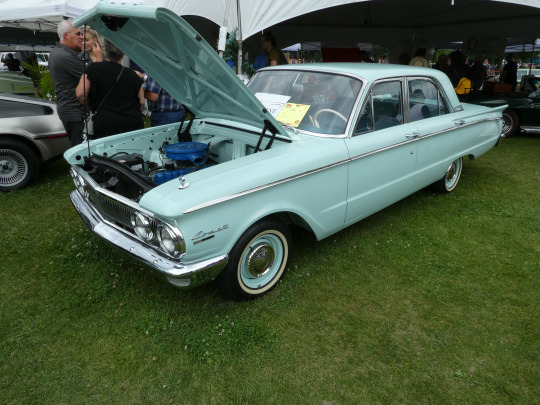
- Tout près de la porte d’entrée, il y avait cette Mercury Comet de 1961 dans un état encore plus spectaculaire que toute unité sortie des usines des Ford en cette année-là. Peut- être un peu trop détaillée pour un véhicule aussi prolétaire… (Photo Éric Descarries)
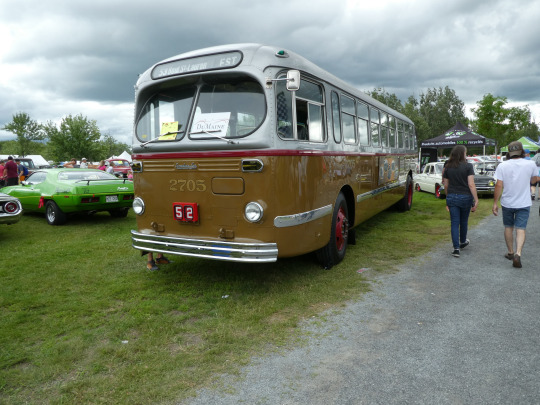
- Les visiteurs un peu plus vieux ont été étonnés de voir ce bus Canadian Car (d’origine anglaise Brill) aux couleurs de la Commission des Transports de Montréal, un véhicule de la fin des années cinquante qui circulait dans les rues de Montréal! (Photo Éric Descarries)
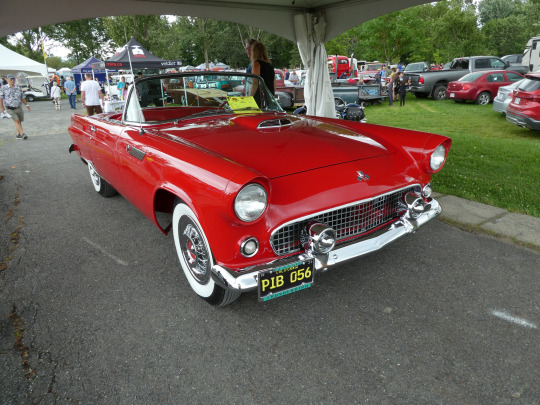
- Une Ford Thunderbird 1955! Plus «classique» que cela, c’est presque impossible! Dire qu’elle est aussi belle qu’à ses premiers jours. (Photo Éric Descarries)
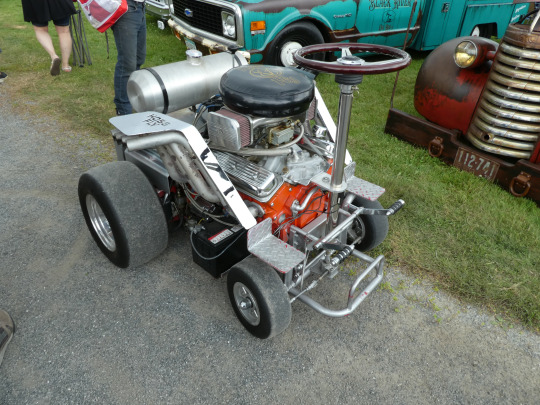
- OK! Plus fou que cela, tu meurs, n’est-ce pas? Mais je l’avais déjà vu en action lors d’un «show de rods» au Vermont, il y a quelques années. Il fonctionne pour de vrai! Un tabouret mû par un V8 Chevrolet! (Photo Éric Descarries)
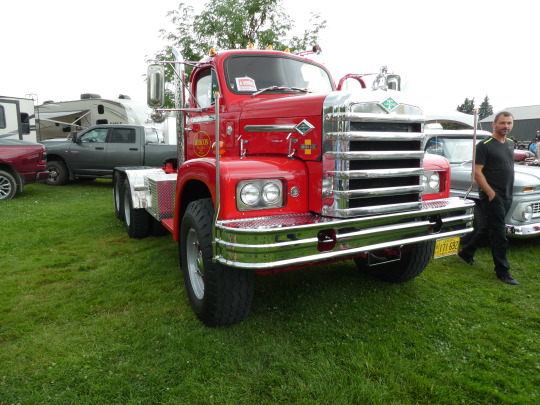
- Un camion Diamond T des années soixante! Quelqu’un se souvient-il de cette marque qui est devenu Diamond Reo avant de disparaître au cours des années soixante-dix? Un vrai «truck»! (Photo Éric Descarries)
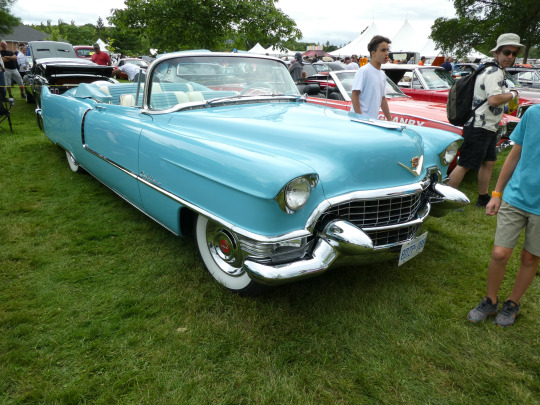
- Que serait un «show» de voitures anciennes sans une Cadillac des années cinquante? Dommage que cette marque américaine si spectaculaire ait perdu tant de prestige. En espérant qu’elle le retrouve un jour! (Photo Éric Descarries)
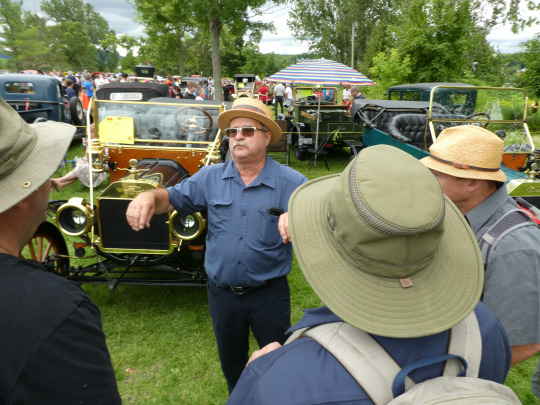
- Mon bon ami Guy Dufresne de Mascouche est toujours présent quand il s’agit de Ford Model T. Il en connaît plus que bien du monde à ce sujet. Derrière lui, sa propre T de 1912 que j’ai conduite et qui a servi à un reportage tant à mon blogue qu’au site Auto 123. (Photo Éric Descarries)

- Outre la MGB, on pourrait dire que la Triumph TR3 est une autre de ces autos classiques britanniques «ports car» des années cinquante et soixante! (Photo Éric Descarries)

- Bien avant la Honda Civic du début des années soixante-dix, il y avait la Honda N600…une micro voiture à moteur à deux cylindres que les Japonais avaient envoyé en Amérique en rêvant que…(Photo Éric Descarries)

- Vous croyez que ce véhicule est un Ford Econoline? Erreur, en version passagers, c’était un Falcon! Celui-ci représente les débuts des VR, l’ennemi à venir des Volks Westfalia ! (Photo Éric Descarries)

- La voici donc la fameuse Trabant de l’Allemagne de l’Est des années soixante-dix! À cette époque de la politique communiste, les pro-soviétiques croyaient que c’était la réponse à la Coccinelle Volkswagen! Ouf! (Photo Éric Descarries)

- La Rolls-Royce Silver Cloud de 1961, LA plus classique des Rolls-Royce modernes…du moins, selon moi! (Photo Éric Descarries)

- Une réplique de Porsche 550 RS, le même type de voiture que celle dans laquelle l’acteur américain James Dean allait trouver la mort! (Photo Éric Descarries)
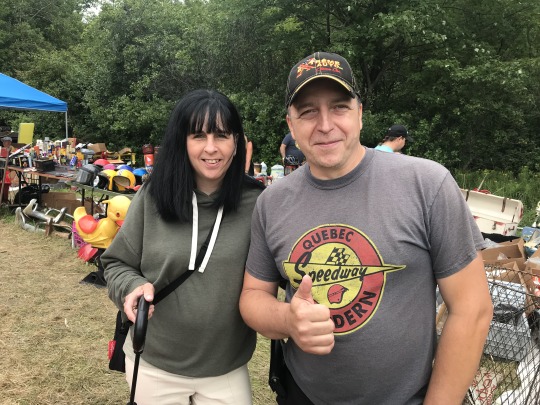
- On rencontre toutes sortes de gens au Granby International. Dans mon cas, après plus de deux ans d’absence (COVID oblige), j’y ai rencontré un très grand nombre d’amis, de compagnons et même de concurrents du passé. Je m’y suis même fait de nouveaux amis dont Yannick Arsenault de la maintenant populaire émission Transmission Impossible (sur Historia). Ironiquement, Yannick, que l’on voit ici avec sa compagne, avait déjà fait affaire avec d’autres de mes amis dont le légendaire Gilles Samson, mon ami collectionneur d’autoneiges Bombardier! Comme quoi le monde est petit! (Photo Éric Descarries)
Décidément, il nous faudrait d’autres Granby International pour conserver cet amour de l’automobile au Québec. Déjà que le Sommet des Légendes a (encore) été suspendu au Circuit du Mont-Tremblant cette année…au moins, il nous reste le concours d’élégance du VAQ à Chambly! Espérons que le club des Voitures Anciennes de Granby tiendra le coup. En passant, on ne devrait pas dire auto «antique», c’est un anglicisme! En français, le mot «antique» fait plutôt référence à la Grèce, à la Rome ou à l’Égypte antique! Ce sont donc des véhicules anciens…n’est-ce pas?
0 notes
Text
While the world melts around me, I look to Colorado’s landscape for relief
get headlines https://thecherrycreeknews.com
I wake every morning looking out at the still-snowcapped Byers Peak with a pinkish hue from the sunrise. I believe in starting each day by giving gratitude and now more than ever I realize the importance of being grateful for my life.
While the world is melting down around me, I watch Instagram-worthy sunsets over the mountains each evening. I take photos nearly every evening and am in awe of the ever-changing kaleidoscope.
Sweet Pea, the year-old Australian Cattle Dog/Blue Heeler we rescued less than a month ago, seems to be equally enthralled by the spectacular landscape that surrounds us. She sits on our bed upstairs looking out, or on the deck in the backyard with a keen eye looking for the fox and lone coyote that roam the fields behind us.
Spring is upon us and the snow is finally melting. In the last week, the pond behind the house has completely thawed and the geese and ducks have taken up residence. The peepers are starting to chirp quietly and I am looking forward to their full-blown chorus. I am watching a crow build a very large nest in the eaves of my neighbors house. Tonight I watched the full moon rise over Granby Ranch.
I have so much to be grateful for.
MORE: See all of our Write On, Colorado entries and learn how to submit your own here.
Meanwhile, around the country, the new normal of our overturned society is so different from person to person and place to place. I talked to a colleague who leaves her groceries in the garage for a few days before bringing them into the house for scrubbing.
A close friend FaceTimed me from New York City while walking down an empty Lexington Avenue in front of Bloomingdales with a mask on. She was heading to the subway to Queens where she planned to rent a car and drive around to get out of the one-bedroom apartment she shares with her teenage daughter.
Others talk shockingly matter-of-factly about family and friends who have died from COVID-19, the illness associated with the new coronavirus. Yet other people I speak to are going about their day-to-day life as if nothing has changed. Going to the office. Babysitting their grandkids. Dropping into happy hour at the local bar.
Me? I’m sheltering in place in Granby, Colorado, with my significant other.
It has been over a month since my work travel was canceled and I haven’t left Granby since. I am working more hours than ever for less money due to what I hope are temporary pay cuts, but I am grateful to have a job.
Our house is not large enough for two home offices so I have set up my desk at the dining room table and am fortunate to have a wall of windows looking out at an incredible view. My biggest challenge in prepping for my virtual video meetings is finding a suitable backdrop in a house that has more windows than walls. I frequently opt for the wall with the coat rack filled with cowboy hats, which prompts quite a few comments from colleagues around the country.
Yesterday, a California colleague commented how Zoom has made us all so real, saying that “cowboy hats are so you.”
Most days, I take a hike with my dogs, Sweet Pea and Bandit, on a trail nearby where I rarely see anyone. The panoramic view is incredible and I remind myself how lucky I am to be here in Grand County.
We keep our horses at a ranch in Fraser and drive out at the end of our work day to feed them. This week we started shedding them and working them. Once a week or so someone else shows up at the ranch to do the same but we are well apart from one another.
Admittedly, having lived in the mountains of Vermont for many years, I am not a fan of mud season/shoulder season. I am typically not uptight about getting dirty but for me there is nothing worse than a pasture of snow, mud, ice, urine and manure.
Already registered? Log in here to hide these messages.
Stay on top of it all.
Let us bring Colorado’s best journalism to you. Get our free newsletters.
UNDERWRITTEN BY TOBACCO-FREE KIDS ACTION FUND
OUR UNDERWRITERS SUPPORT JOURNALISM. BECOME ONE.
Our plan was to take the horses to a friend’s ranch in Elizabeth for April and May and stay in Denver. But those plans, like all others, have changed. So instead, I walk my horse through the ankle deep mud hoping my boots don’t get sucked off and try to stay focused on the incredible beauty of the surrounding mountains and the bright blue sky.
I breathe in the fresh air and think about a good friend who had the virus and told me that for three days she felt like there was a fire in her lungs. Fortunately, she has recovered and she too can once again appreciate the fresh mountain air.
On the way home from the ranch, I stop into Murdoch’s to pick up horse wormer and become acutely aware that everyone but me is wearing a mask. This is my first time at a store in five days and the governor just started to encourage everyone to wear a mask last evening so I realize I am behind the curve.
I feel like I am in a sci-fi movie and suddenly I’m totally freaked out and can’t wait to get home to my safe haven. I start to wonder if there is a light at the end of this very long, strange tunnel.
Tonight as I lie in bed, the full moon is lighting up the cloudless sky. I am restless and am trying to envision what life will be like if we ever get to the other side of this pandemic. I attempt to meditate but my mind will not stop racing.
I think of the beautiful words written by Kitty O’Meara that were shared by Deepak Chopra and wonder if we will “make new choices, create new ways to live and heal the Earth fully.” As I toss and turn, my mind slingshots, wondering if we will be beaten and broken in the wallet when this is over or if we will be refreshed and renewed. Only time will tell.
Sweet Pea wakes and I take her outside and stand on the deck in my robe looking out at the moonlit landscape. It is truly breathtaking. And I am grateful to be in Granby during these unprecedented times.
Lisa Piccardo is a member of the Grand County Community of Writers who lives in Granby.
Already registered? Log in here to hide these messages.
Stay on top of it all.
Let us bring Colorado’s best journalism to you. Get our free newsletters.
The latest from The Sun
Meatpackers welcome Trump’s order that they stay open while others — including Colorado’s governor — question the coronavirus risks
Skier killed in avalanche near Crested Butte
Colorado hopes to test anyone with coronavirus symptoms by May 15, governor says
Colorado nursing home, senior care center coronavirus deaths hit 431, make up 56% of state’s fatalities
Texas attorney general helped donor fight virus lockout in Gunnison County
from https://ift.tt/3aNdqYr https://ift.tt/3d5f5tV
0 notes
Text
Get your copy of our latest magazine, Adrenaline’s Souvenir Album - 12 years of car shows from New Brunswick to Merrickville, ON to Vermont and New York, at this year’s Granby International car Show in Granby, QC.

0 notes
Text
Route 102, Guildhall and Granby Vermont
As you look at the map you may or may not realize that the border of Vermont and New Hampshire is not Route 91. It’s actually Route 5 and the Connecticut River. So there is about 25 miles of Vermont to the east of I-91. This is the eastern side of the NEK (Northeast Kingdom). This is one route you can explore and enjoy.
Follow along Route 102 From Canaan Vermont in the north to where it starts, down to where it ends on Bridge street in Lancaster New Hampshire. But no, there is no covered bridge on this street, sorry, for that, follow Bridge St to Main St and to the right and then a left on Mechanic Street to the Mechanic Street Covered Bridge but that’s another story.
This Route 102 will take you along 50 miles of rolling farmland and scenic views of Vermont and New Hampshire. To the east of the road is the Connecticut River and I’m going to concentrate on Guildhall portion to the south. The big attraction is the Gristmill on the Old Crawford farm. (image below from a past year)
gristmill with waterwheel (its actually in VT but almost in NH)
Now I saw this gristmill on Flickr and I was intrigued enough to ask the photographer where it was located, all they would say is, it’s in Guildhall Vermont. I went up there in 2012 looking for it and there are hundreds of side roads so I was searching for a needle in a haystack. I finally stopped at the town hall and when I walked in, you know they sell greeting cards of this very gristmill. They told me to head south and turn on Granby road. (Not such a needle after all)
For those coming up from the south: The farm is just north of Lancaster and if you set your mileage counter to zero, you will travel about 4.8 miles until you hit Granby Rd. if you are coming from the South it’s on the left. If you are coming from the North, it’s on the… Well you can figure that out, right?
Old Crawford farm grist mill marker
There is a brass marker on a large rock at the intersection to let you know you are near. Turn onto Granby Rd and be ready to pull over. You will see a sign for the Old Crawford Farm and just a little further on the right, you will see the fence and pull over. There is a ditch there so don’t pull over too far. (You’ve been warned)
Photographing the Gristmill
I find early morning light can be wonderful especially if the colors are a bright orange. The main vantage points are from down the road as you were approaching it. Then successive shots as you get closer.
To start, I like including the wooden fence that runs up the back side of the mill as a leading line or along the front. Then I walk down the road towards the wooden mill building and shoot it from less of an angle and then from straight on. (As seen below, all are from previous years)
#gallery-0-7 { margin: auto; } #gallery-0-7 .gallery-item { float: left; margin-top: 10px; text-align: center; width: 20%; } #gallery-0-7 img { border: 2px solid #cfcfcf; } #gallery-0-7 .gallery-caption { margin-left: 0; } /* see gallery_shortcode() in wp-includes/media.php */
Guildhall Vermont Grist mill as a painting 2013
Gristmill in Guildhall Vermont. 2013
The Guildhall gristmill that belongs to the Old Crawford farm trust in 2012
The Guildhall Grist mill as a vertical in 2012
The Grist mill belonging to that Old Crawford farm in 2012
Here you can see the differences from a vertical angle and the horizontal and how the images changes. You are the artist creating the final product. Move your feet and turn the camera to portrait or landscape to make your image come alive.
Questions? Leave a comment
Vermonts Route 102 Route 102, Guildhall and Granby Vermont As you look at the map you may or may not realize that the border of Vermont and New Hampshire is not Route 91.
#Autumn in New England#back roads#Crawford farm#dirt road#Fall colors#Fall foliage planning#fall foliage routes#Foliage Routes#Granby#Grist Mill#Guildhall#guildhall Vermont#New england fall foliage#Route 102#Vermont
1 note
·
View note
Text
Book review: Heller’s “The River” is a fiery tour de force
Fiction The River By Peter Heller (Knopf)
There is a line in Peter Heller’s newest book, “The River,” that one could use to explain it.
On the page, it’s referring to the northern lights, but it’s also a perfect description of the captivating and poetic thriller: “It was terrifying and unutterably beautiful.”
Jack and Wynn are college buddies, men whose friendship has been forged by their mutual love of books and the outdoors. They’re on a long canoeing trip in northern Canada that unexpectedly takes a turn into part mystery (a man, likely in shock, whose wife has gone missing in the woods) and part action-adventure (there’s a giant, hellish forest fire burning behind them).

“The River” is Heller’s fourth work of fiction, and it recalls his debut, “The Dog Stars,” with its poetic, staccato sentences and masterfully crafted prose. Not to mention a Colorado connection — Heller lives in Denver. “The Dog Stars” was set along the Front Range, and, here, Jack grows up on a ranch outside of Granby, learning survival and toughness in the rugged Colorado landscapes.
The story itself resembles a trip down a river — some parts are peaceful and allow for quiet introspection and big, deep breaths. But then you hit the rapids and the danger and risk jump off the page, forcing a sense of urgency.
In those thrilling parts, reading required self-discipline. I wanted to know what happened so badly that I’d read too fast and had to retrace my steps to savor Heller’s storytelling.
And what a story he tells. On the technical side, it’s brimming with authenticity and there was more than enough gear talk. (I have never been in a canoe. I have seen “Deliverance,” and that’s close enough, but I didn’t get lost in jargon.) Heller is an experienced outdoorsman and whitewater kayaker, (so, of course he lives in Colorado), and it shows here.
The wilderness is more a character than a setting, and Heller captures its duality. The serenity of drifting down a calm river at night: “They loved how the darkness amplified the sounds — the gulp of the dipping paddles, the knock of the wood shaft against the gunwale. The long desolate cry of a loon.” And the sheer terror of a wildfire baring down: “The burning debris rained down, they swiped it off arms, shoulders … an inconstant blizzard of sparks, bunches of pine needles flaming like flares, birch leaves ignited to molten lace rained down, but the wind had gone quiet, it eddied as if confused, circled around them like a dog settling for sleep … .”
With Heller’s background, the fully developed main characters are entirely credible. Jack is cautious and watchful, his childhood shadowed by a tragedy, and Wynn is a Vermont kid who believes in the goodness of people. But they are both just carefree college boys who are largely unprepared for the events that await them on what was supposed to be a trip full of fishing and stargazing.
That includes finding the wife of the man who Jack and Wynn encounter, severely injured and near death, and crossing paths with two drunken rednecks before the wildfire — and the intention of the man the find paddling down the river — forces a fight of survival.
At the heart of the book is the delicate dance of beauty and brutality. And it plays out in the wilderness that Jack and Wynn seek out and in the characters themselves — and in the people they meet.
The wildfire is fearsome and unpredictable, burning one tree down, only to leave another unscathed. So, too, is one man’s violence or another man’s hubris.
I could not put this book down. It truly was terrifying and unutterably beautiful.
Journalism doesn’t grow on trees. Please support The Denver Post. Become a subscriber for only 99 cents for the first month.
from News And Updates https://www.denverpost.com/2019/02/21/book-review-the-river-peter-heller/
0 notes
Text
Book review: Heller’s “The River” is a fiery tour de force
Fiction The River By Peter Heller (Knopf)
There is a line in Peter Heller’s newest book, “The River,” that one could use to explain it.
On the page, it’s referring to the northern lights, but it’s also a perfect description of the captivating and poetic thriller: “It was terrifying and unutterably beautiful.”
Jack and Wynn are college buddies, men whose friendship has been forged by their mutual love of books and the outdoors. They’re on a long canoeing trip in northern Canada that unexpectedly takes a turn into part mystery (a man, likely in shock, whose wife has gone missing in the woods) and part action-adventure (there’s a giant, hellish forest fire burning behind them).

“The River” is Heller’s fourth work of fiction, and it recalls his debut, “The Dog Stars,” with its poetic, staccato sentences and masterfully crafted prose. Not to mention a Colorado connection — Heller lives in Denver. “The Dog Stars” was set along the Front Range, and, here, Jack grows up on a ranch outside of Granby, learning survival and toughness in the rugged Colorado landscapes.
The story itself resembles a trip down a river — some parts are peaceful and allow for quiet introspection and big, deep breaths. But then you hit the rapids and the danger and risk jump off the page, forcing a sense of urgency.
In those thrilling parts, reading required self-discipline. I wanted to know what happened so badly that I’d read too fast and had to retrace my steps to savor Heller’s storytelling.
And what a story he tells. On the technical side, it’s brimming with authenticity and there was more than enough gear talk. (I have never been in a canoe. I have seen “Deliverance,” and that’s close enough, but I didn’t get lost in jargon.) Heller is an experienced outdoorsman and whitewater kayaker, (so, of course he lives in Colorado), and it shows here.
The wilderness is more a character than a setting, and Heller captures its duality. The serenity of drifting down a calm river at night: “They loved how the darkness amplified the sounds — the gulp of the dipping paddles, the knock of the wood shaft against the gunwale. The long desolate cry of a loon.” And the sheer terror of a wildfire baring down: “The burning debris rained down, they swiped it off arms, shoulders … an inconstant blizzard of sparks, bunches of pine needles flaming like flares, birch leaves ignited to molten lace rained down, but the wind had gone quiet, it eddied as if confused, circled around them like a dog settling for sleep … .”
With Heller’s background, the fully developed main characters are entirely credible. Jack is cautious and watchful, his childhood shadowed by a tragedy, and Wynn is a Vermont kid who believes in the goodness of people. But they are both just carefree college boys who are largely unprepared for the events that await them on what was supposed to be a trip full of fishing and stargazing.
That includes finding the wife of the man who Jack and Wynn encounter, severely injured and near death, and crossing paths with two drunken rednecks before the wildfire — and the intention of the man the find paddling down the river — forces a fight of survival.
At the heart of the book is the delicate dance of beauty and brutality. And it plays out in the wilderness that Jack and Wynn seek out and in the characters themselves — and in the people they meet.
The wildfire is fearsome and unpredictable, burning one tree down, only to leave another unscathed. So, too, is one man’s violence or another man’s hubris.
I could not put this book down. It truly was terrifying and unutterably beautiful.
Journalism doesn’t grow on trees. Please support The Denver Post. Become a subscriber for only 99 cents for the first month.
from Latest Information https://www.denverpost.com/2019/02/21/book-review-the-river-peter-heller/
0 notes
Text
Book review: Heller’s “The River” is a fiery tour de force
Fiction The River By Peter Heller (Knopf)
There is a line in Peter Heller’s newest book, “The River,” that one could use to explain it.
On the page, it’s referring to the northern lights, but it’s also a perfect description of the captivating and poetic thriller: “It was terrifying and unutterably beautiful.”
Jack and Wynn are college buddies, men whose friendship has been forged by their mutual love of books and the outdoors. They’re on a long canoeing trip in northern Canada that unexpectedly takes a turn into part mystery (a man, likely in shock, whose wife has gone missing in the woods) and part action-adventure (there’s a giant, hellish forest fire burning behind them).

“The River” is Heller’s fourth work of fiction, and it recalls his debut, “The Dog Stars,” with its poetic, staccato sentences and masterfully crafted prose. Not to mention a Colorado connection — Heller lives in Denver. “The Dog Stars” was set along the Front Range, and, here, Jack grows up on a ranch outside of Granby, learning survival and toughness in the rugged Colorado landscapes.
The story itself resembles a trip down a river — some parts are peaceful and allow for quiet introspection and big, deep breaths. But then you hit the rapids and the danger and risk jump off the page, forcing a sense of urgency.
In those thrilling parts, reading required self-discipline. I wanted to know what happened so badly that I’d read too fast and had to retrace my steps to savor Heller’s storytelling.
And what a story he tells. On the technical side, it’s brimming with authenticity and there was more than enough gear talk. (I have never been in a canoe. I have seen “Deliverance,” and that’s close enough, but I didn’t get lost in jargon.) Heller is an experienced outdoorsman and whitewater kayaker, (so, of course he lives in Colorado), and it shows here.
The wilderness is more a character than a setting, and Heller captures its duality. The serenity of drifting down a calm river at night: “They loved how the darkness amplified the sounds — the gulp of the dipping paddles, the knock of the wood shaft against the gunwale. The long desolate cry of a loon.” And the sheer terror of a wildfire baring down: “The burning debris rained down, they swiped it off arms, shoulders … an inconstant blizzard of sparks, bunches of pine needles flaming like flares, birch leaves ignited to molten lace rained down, but the wind had gone quiet, it eddied as if confused, circled around them like a dog settling for sleep … .”
With Heller’s background, the fully developed main characters are entirely credible. Jack is cautious and watchful, his childhood shadowed by a tragedy, and Wynn is a Vermont kid who believes in the goodness of people. But they are both just carefree college boys who are largely unprepared for the events that await them on what was supposed to be a trip full of fishing and stargazing.
That includes finding the wife of the man who Jack and Wynn encounter, severely injured and near death, and crossing paths with two drunken rednecks before the wildfire — and the intention of the man the find paddling down the river — forces a fight of survival.
At the heart of the book is the delicate dance of beauty and brutality. And it plays out in the wilderness that Jack and Wynn seek out and in the characters themselves — and in the people they meet.
The wildfire is fearsome and unpredictable, burning one tree down, only to leave another unscathed. So, too, is one man’s violence or another man’s hubris.
I could not put this book down. It truly was terrifying and unutterably beautiful.
Journalism doesn’t grow on trees. Please support The Denver Post. Become a subscriber for only 99 cents for the first month.
from News And Updates https://www.denverpost.com/2019/02/21/book-review-the-river-peter-heller/
0 notes
Text
Book review: Heller’s “The River” is a fiery tour de force
Fiction The River By Peter Heller (Knopf)
There is a line in Peter Heller’s newest book, “The River,” that one could use to explain it.
On the page, it’s referring to the northern lights, but it’s also a perfect description of the captivating and poetic thriller: “It was terrifying and unutterably beautiful.”
Jack and Wynn are college buddies, men whose friendship has been forged by their mutual love of books and the outdoors. They’re on a long canoeing trip in northern Canada that unexpectedly takes a turn into part mystery (a man, likely in shock, whose wife has gone missing in the woods) and part action-adventure (there’s a giant, hellish forest fire burning behind them).

“The River” is Heller’s fourth work of fiction, and it recalls his debut, “The Dog Stars,” with its poetic, staccato sentences and masterfully crafted prose. Not to mention a Colorado connection — Heller lives in Denver. “The Dog Stars” was set along the Front Range, and, here, Jack grows up on a ranch outside of Granby, learning survival and toughness in the rugged Colorado landscapes.
The story itself resembles a trip down a river — some parts are peaceful and allow for quiet introspection and big, deep breaths. But then you hit the rapids and the danger and risk jump off the page, forcing a sense of urgency.
In those thrilling parts, reading required self-discipline. I wanted to know what happened so badly that I’d read too fast and had to retrace my steps to savor Heller’s storytelling.
And what a story he tells. On the technical side, it’s brimming with authenticity and there was more than enough gear talk. (I have never been in a canoe. I have seen “Deliverance,” and that’s close enough, but I didn’t get lost in jargon.) Heller is an experienced outdoorsman and whitewater kayaker, (so, of course he lives in Colorado), and it shows here.
The wilderness is more a character than a setting, and Heller captures its duality. The serenity of drifting down a calm river at night: “They loved how the darkness amplified the sounds — the gulp of the dipping paddles, the knock of the wood shaft against the gunwale. The long desolate cry of a loon.” And the sheer terror of a wildfire baring down: “The burning debris rained down, they swiped it off arms, shoulders … an inconstant blizzard of sparks, bunches of pine needles flaming like flares, birch leaves ignited to molten lace rained down, but the wind had gone quiet, it eddied as if confused, circled around them like a dog settling for sleep … .”
With Heller’s background, the fully developed main characters are entirely credible. Jack is cautious and watchful, his childhood shadowed by a tragedy, and Wynn is a Vermont kid who believes in the goodness of people. But they are both just carefree college boys who are largely unprepared for the events that await them on what was supposed to be a trip full of fishing and stargazing.
That includes finding the wife of the man who Jack and Wynn encounter, severely injured and near death, and crossing paths with two drunken rednecks before the wildfire — and the intention of the man the find paddling down the river — forces a fight of survival.
At the heart of the book is the delicate dance of beauty and brutality. And it plays out in the wilderness that Jack and Wynn seek out and in the characters themselves — and in the people they meet.
The wildfire is fearsome and unpredictable, burning one tree down, only to leave another unscathed. So, too, is one man’s violence or another man’s hubris.
I could not put this book down. It truly was terrifying and unutterably beautiful.
Journalism doesn’t grow on trees. Please support The Denver Post. Become a subscriber for only 99 cents for the first month.
from Latest Information https://www.denverpost.com/2019/02/21/book-review-the-river-peter-heller/
0 notes
